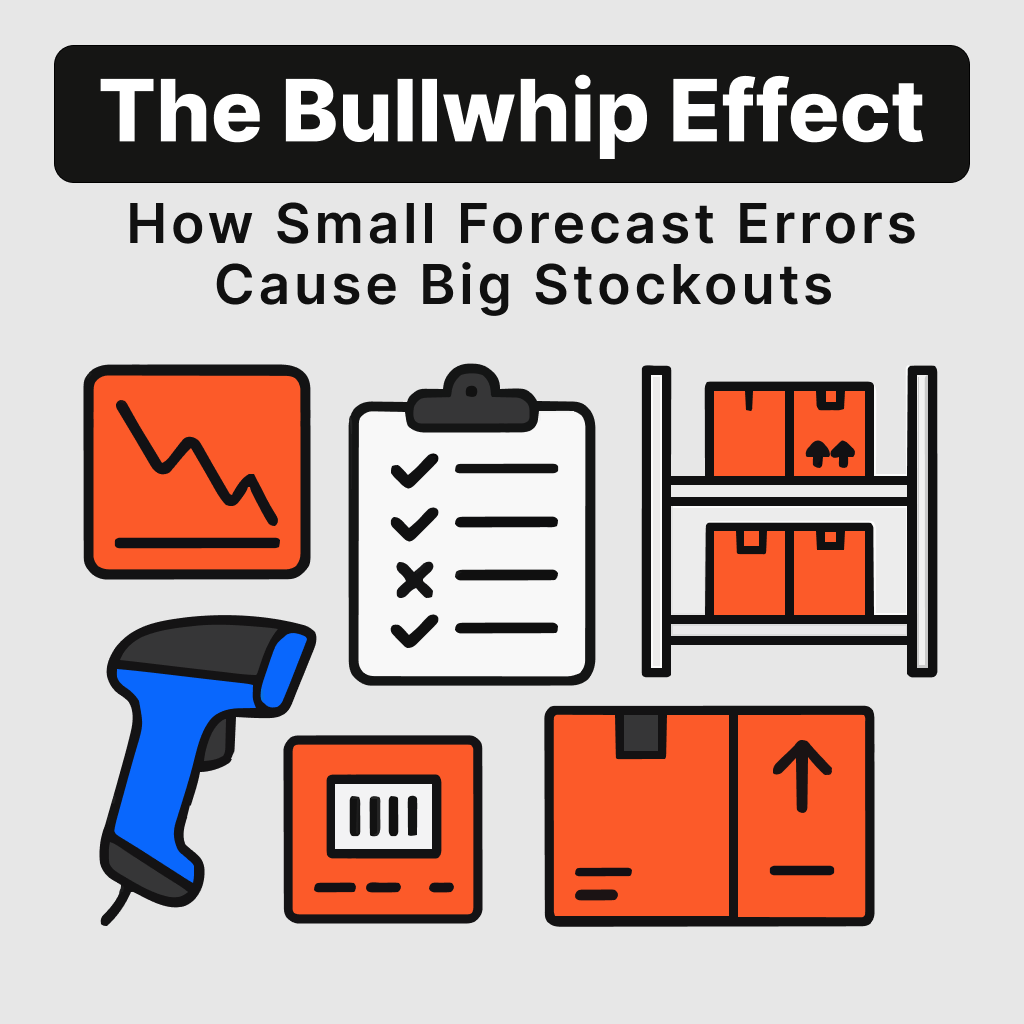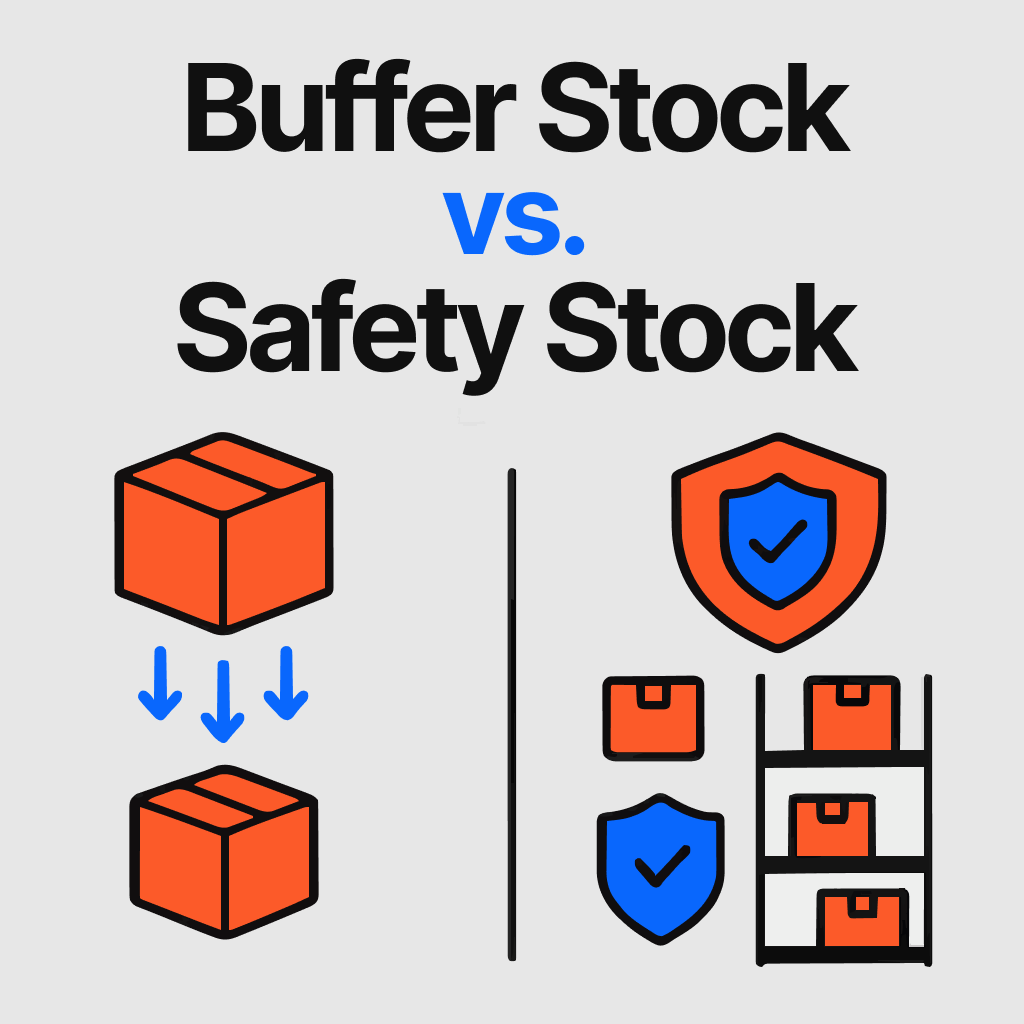Imagine walking into your warehouse and realizing the shelves are bare of the one component you need to keep production running. Customer orders are stacking up, deadlines are slipping, and your team is scrambling to source emergency supplies at triple the usual cost. What makes it more frustrating is that this crisis didn’t come from a factory breakdown or a supplier strike - it started with something deceptively small: a minor forecasting error.
This is the paradox that manufacturers face every day. Tiny miscalculations in predicting demand don’t just cause small inconveniences - they multiply, ripple, and escalate until they create massive disruptions across your entire supply chain. This is the essence of the bullwhip effect, a hidden force that silently magnifies small fluctuations into costly stockouts and inefficiencies.
In this post, we’ll break down how the bullwhip effect works, why even stable markets aren’t immune, and what real-world consequences inaccurate forecasting brings to your business. Most importantly, you’ll discover practical strategies and advanced forecasting techniques that leading manufacturers use to protect themselves from volatility.
With this foundation in place, let’s start by exploring how small inaccuracies ripple through the supply chain and grow into large-scale disruptions.
The Ripple Effect: How Small Inaccuracies Create Massive Waves
The relationship between small forecasting errors and large stockouts might seem counterintuitive at first. After all, shouldn't a 5% error in demand prediction only create a 5% shortage? Unfortunately, supply chains don't work that way. They amplify errors at each stage, turning minor miscalculations into major disruptions.
Here's how this amplification process unfolds in real manufacturing environments.
When retailers experience a small uptick in customer demand, they typically order more inventory from wholesalers to ensure they don't run out of popular items. The wholesaler, seeing increased orders from multiple retailers, interprets this as a significant market shift and places even larger orders with manufacturers. Manufacturers, in turn, ramp up production and order substantial quantities of raw materials from their suppliers.
This cascading effect means that what started as a modest 10% increase in consumer demand can result in a 40% spike in raw material orders at the manufacturing level. When that initial demand surge turns out to be temporary or smaller than anticipated, you're left with the opposite problem: massive excess inventory that ties up your capital and warehouse space.
The real challenge emerges when demand patterns shift in the other direction. A small decrease in actual demand compared to forecasted demand creates the same amplification effect in reverse, leading to significant shortages throughout the supply chain that can bring your production floor to a complete standstill.
The Bullwhip Effect in Manufacturing: Understanding the Core Challenge
The phenomenon described above has a name: the bullwhip effect in manufacturing. This term perfectly captures how small movements at one end of your supply chain create increasingly dramatic swings at the other end, much like cracking a whip.
The concept gained recognition when researchers at Procter & Gamble studied the supply chain for Pampers diapers. Despite relatively stable consumer demand for diapers, they observed wild fluctuations in orders and inventory levels as they moved up the supply chain from retailers to distributors to the manufacturer itself. This discovery revolutionized how we understand supply chain volatility.
In manufacturing environments, the bullwhip effect manifests in several ways. You might notice erratic ordering patterns from your customers, unpredictable demand for your raw materials, and production schedules that swing between overtime rushes and extended idle periods. These symptoms often puzzle manufacturing leaders because they don't align with the seemingly steady market demand for their end products.
The bullwhip effect becomes particularly pronounced in industries with longer lead times, complex product configurations, or seasonal demand patterns. However, no manufacturing operation is immune to its impact. Even businesses producing everyday essentials can experience dramatic supply chain volatility when small forecasting errors compound through their network of suppliers and customers.
Understanding this effect empowers you to recognize early warning signs and implement preventive measures before small errors become big problems. It shifts your focus from reactive problem-solving to proactive supply chain management.
Real-World Consequences of Inaccurate Inventory Forecasting
Poor inventory forecasting doesn’t just create headaches - it carries massive financial and operational consequences for manufacturers.
- Financial losses: Inventory distortion costs retailers about $1.8 trillion annually, with stockouts alone driving $1.2 trillion. For manufacturers, that means halted production, emergency sourcing, and expensive expedited shipping.
- Lost sales and customers: Stockouts typically cause a 4% sales loss, but missed deliveries in manufacturing can push customers toward competitors and damage long-term relationships.
- Operational disruption: When key parts are unavailable, production stalls. Downtime wastes labor and equipment capacity while delays cascade through the fulfillment pipeline.
- Supplier strain: Erratic order patterns from poor forecasting make it harder for suppliers to plan, often resulting in longer lead times, higher costs, or reduced priority for your business.
- Hidden costs: Emergency shipping, overtime pay, and sourcing premiums can cost 3–5x more than planned procurement, quickly eroding profit margins.
In short, inaccurate forecasting doesn’t just affect inventory - it undermines profitability, efficiency, and relationships across your entire supply chain.
What Causes Supply Chain Volatility? Drivers of Demand Distortion
Several factors contribute to the amplification of forecasting errors throughout your supply chain. Understanding these drivers helps you pinpoint where interventions will have the greatest impact on your inventory forecasting accuracy.
Poor Communication and Limited Data Sharing
When partners in the supply chain don’t share accurate, real-time information, small misunderstandings quickly escalate into large distortions. Lack of alignment makes each party rely on assumptions instead of facts.
- Siloed decision-making: Without integrated communication, each partner independently interprets demand and makes disconnected decisions.
- Misinterpreted order signals: Suppliers often mistake replenishment orders as signs of broader demand growth.
- Overproduction risk: These misinterpretations push suppliers to produce more than necessary, creating excess inventory that becomes costly once demand evens out.
Improving transparency and data sharing across all stakeholders is the first step toward preventing these unnecessary amplifications.
Order Batching
Order batching happens when businesses consolidate purchases for convenience, cost savings, or policy reasons. While efficient administratively, it creates misleading spikes in demand.
- Artificial demand spikes: Large, infrequent orders look like sudden surges, even if customer consumption remains steady.
- Supplier misreading: These patterns cause suppliers to scale up production in anticipation of higher long-term demand.
- Amplification effect: Irregular ordering cascades through the supply chain, destabilizing production and inventory alignment.
Breaking down batch orders into smaller, more frequent ones creates demand patterns that more accurately reflect real market needs.
%201.svg)








.svg)














.svg)
.svg)

.svg)